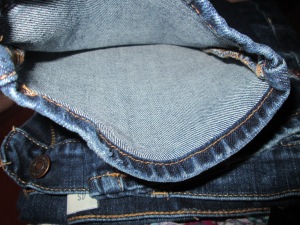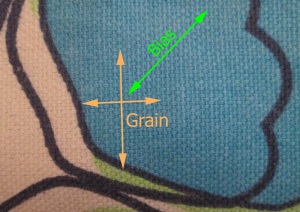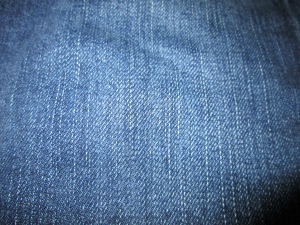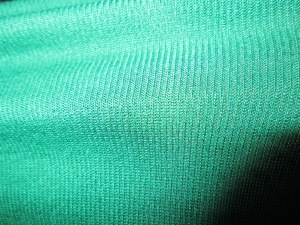When you first visited the fabric store to pick up your basic supplies, you probably noticed that there are seemingly hundreds of different types of fabric to choose from. When I first started sewing and had to buy fabric, my plan of action was always to just find fabric that felt like the same material in my clothing. However, it’s really helpful to learn about fabrics before you spend your money on fabrics that are hard to manage and maneuver.
First, let’s go over some basic terms you’ll hear often when discussing fabrics.
- Right side/wrong side – These refer to what you would think of as the “outside” and the “inside” of the fabric. The right side is the side that is intended to be seen when the garment is worn. The wrong side is the side that is intended to be hidden while wearing the garment. When stitching two pieces of fabric together, you usually pin them with right sides together so that the seam will not be as noticeable from the outside.

Note the difference between the right side (darker) and the wrong side (lighter) of the fabric used for this pair of jeans. Click image to enlarge.
- Grain, bias, selvage – These are directional terms related to your piece of fabric. Grain refers to the straight lines that are visible when looking at the fabric; this is the direction that the fabric was woven or knit. Bias is the diagonal line going across these straight lines in either direction. If you pull on a piece of fabric in the bias direction, it will stretch more than vertically or horizontally. Selvage relates to fabric cut and bought from a fabric store, and it is the length-wise edge of the fabric that is typically parallel with the length-wise grainline. In other words, when you get a piece of fabric cut at the store, they’ll measure the length you want and cut the fabric. The edge that they measure is the selvage edge.

Grainlines and bias direction on canvas. This fabric does not stretch vertically or horizontally, but it does stretch slightly when pulled in the bias direction. Click image to enlarge.
Next, we’ll look at the two groups of fabric into which all types of fabric can be organized: woven and knit.
- Woven fabric is fabric that is created by interlacing and weaving yarn vertically and horizontally. Generally woven fabric does not stretch unless a stretchy fabric is added to the weave like spandex. Common woven fabrics are linen, denim, satin, and canvas.

The canvas fabric pictured above is a good example of woven fabric, as is this denim. Click image to enlarge. - Knit fabric is produced by knitting and interlocking yarn in loops, like a person knitting with two knitting needles but on a much smaller scale. Knit fabrics naturally stretch by design. Common knit fabrics include T-shirt fabric, jersey, and felt. Sewing knits can be more challenging for beginners because of the stretchiness, and I recommend beginning with wovens to make your first projects easier.

A piece of knit fabric stretched completely horizontally. Note the visible loops throughout the fabric. Click image to enlarge.
This is just the beginning of everything there is to know about fabric! However it helps to learn about new fabrics and how to manage them if you first learn the distinction between woven and knits. When you move from the remnant table to selecting from the bolts of fabric lining the walls, these terms will definitely come in handy!
Happy sewing and have a good day!
Learni.st – Learn how to sew starting from step one
Pinterest & Twitter – Follow for tips, ideas, and more
Etsy – Shop Sew Me Your Stuff
